Corporate general liability insurance serves as a crucial safeguard for businesses, shielding them from a wide range of potential liabilities and ensuring their financial stability. This comprehensive coverage provides peace of mind, empowering companies to operate with confidence, knowing they are protected against unforeseen events.
This insurance policy encompasses various scenarios, including property damage, bodily injury, and legal defense costs. By understanding the scope of coverage, policy limits, and claims process, businesses can effectively manage their risk exposure and mitigate potential financial losses.
Coverage Scope
Corporate general liability insurance offers a comprehensive shield against a wide spectrum of liabilities that businesses may encounter during their operations.
This insurance policy covers a diverse range of risks, including:
- Bodily injury or property damage caused to third parties due to the company’s operations, products, or services.
- Legal defense costs incurred in defending against lawsuits alleging such liabilities.
- Medical expenses resulting from injuries sustained by third parties on the company’s premises or during company-related activities.
Exclusions and Limitations
While corporate general liability insurance provides extensive coverage, it is essential to note that certain exclusions and limitations may apply.
- Intentional acts or criminal behavior.
- Liability arising from pollution or environmental damage.
- Claims resulting from contractual obligations.
- Coverage limits may vary depending on the policy and the specific risks covered.
Types of Businesses Covered
Corporate general liability insurance is essential for various businesses due to the diverse risks they face.Businesses that interact with customers, handle products, or operate in potentially hazardous environments are particularly vulnerable to liability claims. These include:
Professional Services
* Accountants, lawyers, and consultants face risks of errors and omissions, leading to financial losses for clients.
Construction and Contracting
* Contractors and builders are exposed to risks of property damage, bodily injury, and contractual disputes.
Retail and Wholesale
* Businesses selling products can face liability for defective products, slip-and-fall accidents, or product recalls.
Healthcare
* Medical professionals and hospitals carry significant risks of medical malpractice and patient injuries.
Manufacturing
* Manufacturers face risks of product liability, workplace accidents, and environmental damage.
Case Study:
A small construction company was sued by a homeowner after a faulty electrical installation caused a fire. Corporate general liability insurance covered the legal expenses, settlement, and repairs, saving the business from financial ruin.
Policy Limits and Deductibles
Policy limits and deductibles are crucial components of corporate general liability insurance. Understanding their functions and impact on coverage is essential for businesses seeking optimal protection.
Policy limits represent the maximum amount an insurer will pay for covered claims within the policy period. Deductibles, on the other hand, refer to the portion of a claim that the policyholder must pay out-of-pocket before the insurance coverage kicks in.
Factors Influencing Coverage Cost
- Industry and Risk Level:Businesses operating in high-risk industries or those with a history of frequent claims may face higher premiums.
- Policy Limits:Higher policy limits result in increased premiums as the insurer assumes a greater financial risk.
- Deductibles:Choosing a higher deductible lowers premiums since the policyholder bears more of the initial financial burden.
- Claims History:A favorable claims history can lead to lower premiums, while a history of frequent or large claims can result in higher costs.
- Business Size and Revenue:Larger businesses with higher revenue may have to pay higher premiums to cover their increased exposure to risks.
Selecting Appropriate Policy Limits and Deductibles
Determining appropriate policy limits and deductibles requires careful consideration of the following factors:
- Potential Liability:Businesses should assess the potential financial impact of covered claims and select policy limits that provide adequate protection.
- Financial Resources:The deductible should be set at a level that the business can comfortably afford to pay without compromising its financial stability.
- Risk Tolerance:Businesses with a higher tolerance for risk may opt for higher deductibles to lower premiums, while those seeking more comprehensive coverage may prefer lower deductibles.
Claims Process

Filing a claim under corporate general liability insurance is a multi-step process that involves the policyholder, the insurance company, and an insurance adjuster. Understanding the steps and requirements involved can help ensure a smooth and efficient claims process.
Steps in Filing a Claim
- Report the incident:Promptly notify the insurance company about the incident giving rise to the claim. This can be done by phone, email, or through the insurer’s online portal.
- Provide documentation:Gather and submit relevant documentation to support the claim, such as witness statements, police reports, medical records, and estimates for repairs or damages.
- Cooperate with the adjuster:An insurance adjuster will be assigned to investigate the claim. The policyholder is expected to cooperate with the adjuster, provide requested information, and allow access to the premises or property involved.
- Negotiate the settlement:The adjuster will evaluate the claim and determine the amount of coverage available. The policyholder may negotiate the settlement amount with the adjuster.
- Receive payment:Once the settlement is agreed upon, the insurance company will issue payment to the policyholder or the third party who suffered the loss.
Role of the Insurance Adjuster
The insurance adjuster plays a crucial role in the claims process. They are responsible for:
- Investigating the claim and gathering evidence
- Determining the cause and extent of the loss
- Evaluating the coverage available under the policy
- Negotiating the settlement amount with the policyholder
- Ensuring that the claim is processed fairly and efficiently
Documentation and Evidence
To support a claim, the policyholder should provide the following documentation and evidence:
- Proof of the incident, such as a police report or witness statements
- Documentation of the damages or injuries sustained
- Estimates for repairs or replacement costs
- Medical records, if applicable
- Any other relevant documentation that supports the claim
Risk Management Strategies

Implementing effective risk management strategies is crucial for businesses to mitigate potential liabilities and protect their operations. Corporate general liability insurance serves as a complementary tool, providing financial protection against unforeseen events and supplementing these strategies.
Risk management strategies involve identifying, assessing, and controlling potential hazards that could lead to legal liability. Businesses can implement various measures to reduce their exposure, including:
Establishing Clear Policies and Procedures
- Developing and implementing comprehensive safety protocols and guidelines.
- Establishing clear policies for employee conduct, including training and supervision.
- Creating written procedures for handling hazardous materials, equipment, and operations.
Regular Inspections and Maintenance
- Conducting regular inspections of premises, equipment, and vehicles to identify potential hazards.
- Performing preventative maintenance to reduce the risk of accidents or equipment failures.
- Keeping records of inspections and maintenance activities for documentation purposes.
Employee Training and Education
- Providing comprehensive training to employees on safety procedures, risk identification, and emergency response.
- Conducting regular refresher courses to reinforce knowledge and ensure compliance.
- Empowering employees to report potential hazards and participate in risk management efforts.
Vendor and Contractor Management, Corporate general liability insurance
- Thoroughly screening and selecting vendors and contractors to ensure they meet safety standards.
- Establishing clear contracts outlining safety responsibilities and liability.
- Monitoring vendor and contractor performance to ensure adherence to safety protocols.
Insurance Coverage
Corporate general liability insurance complements risk management strategies by providing financial protection against unforeseen events. It covers a wide range of potential liabilities, including:
- Bodily injury or property damage caused to third parties
- Libel, slander, or defamation
- Errors and omissions
- Advertising injuries
By implementing comprehensive risk management strategies and securing appropriate insurance coverage, businesses can effectively reduce their exposure to liabilities, protect their assets, and ensure the continuity of their operations.
Closure: Corporate General Liability Insurance
In today’s dynamic business landscape, corporate general liability insurance is an indispensable tool for risk management. It not only protects businesses from financial setbacks but also enhances their reputation and fosters customer trust. By embracing this insurance solution, companies can focus on their core operations, innovate, and thrive in a competitive environment.
Question & Answer Hub
What types of businesses typically require corporate general liability insurance?
Businesses of all sizes and industries can benefit from corporate general liability insurance, but it is particularly crucial for companies that interact with the public, have physical premises, or employ staff.
What are the common exclusions or limitations to coverage?
Coverage typically excludes intentional acts, criminal activities, and damages arising from pollution or environmental hazards. Policy limits and deductibles may also apply.
How can businesses implement risk management strategies to reduce their exposure to liabilities?
Businesses can implement various risk management strategies, such as conducting safety audits, providing employee training, and maintaining proper documentation. These measures can help minimize the likelihood and severity of incidents, reducing the need for insurance claims.
